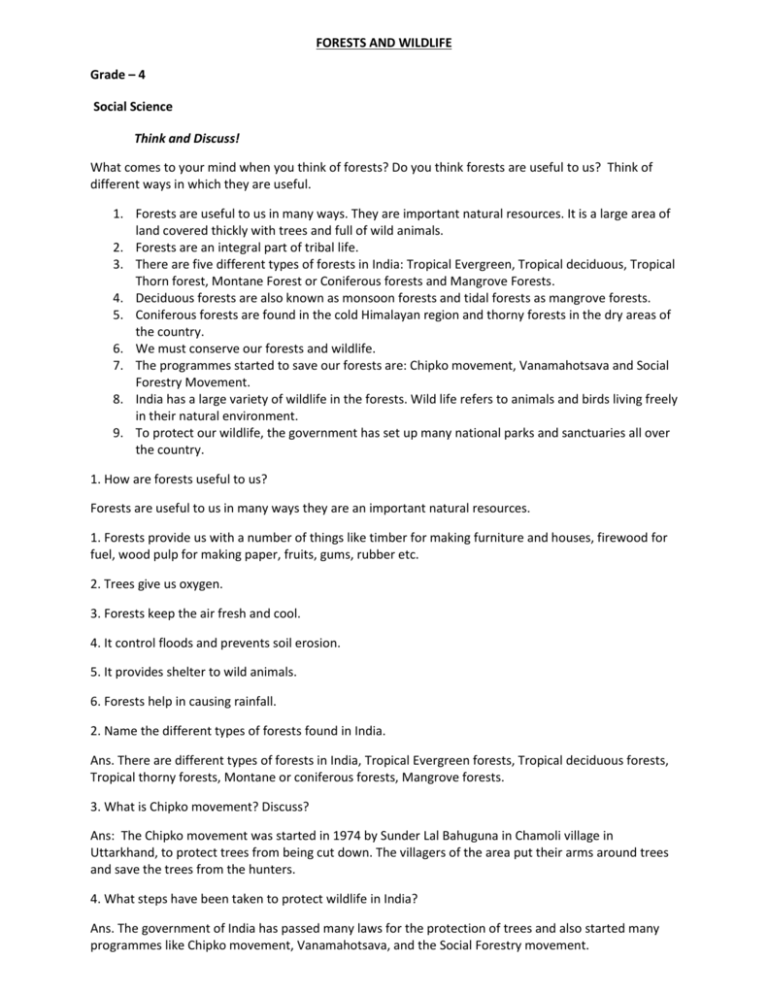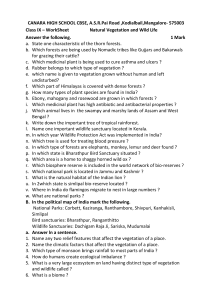FORESTS AND WILDLIFE.notes Ocober 13th
advertisement

FORESTS AND WILDLIFE Grade – 4 Social Science Think and Discuss! What comes to your mind when you think of forests? Do you think forests are useful to us? Think of different ways in which they are useful. 1. Forests are useful to us in many ways. They are important natural resources. It is a large area of land covered thickly with trees and full of wild animals. 2. Forests are an integral part of tribal life. 3. There are five different types of forests in India: Tropical Evergreen, Tropical deciduous, Tropical Thorn forest, Montane Forest or Coniferous forests and Mangrove Forests. 4. Deciduous forests are also known as monsoon forests and tidal forests as mangrove forests. 5. Coniferous forests are found in the cold Himalayan region and thorny forests in the dry areas of the country. 6. We must conserve our forests and wildlife. 7. The programmes started to save our forests are: Chipko movement, Vanamahotsava and Social Forestry Movement. 8. India has a large variety of wildlife in the forests. Wild life refers to animals and birds living freely in their natural environment. 9. To protect our wildlife, the government has set up many national parks and sanctuaries all over the country. 1. How are forests useful to us? Forests are useful to us in many ways they are an important natural resources. 1. Forests provide us with a number of things like timber for making furniture and houses, firewood for fuel, wood pulp for making paper, fruits, gums, rubber etc. 2. Trees give us oxygen. 3. Forests keep the air fresh and cool. 4. It control floods and prevents soil erosion. 5. It provides shelter to wild animals. 6. Forests help in causing rainfall. 2. Name the different types of forests found in India. Ans. There are different types of forests in India, Tropical Evergreen forests, Tropical deciduous forests, Tropical thorny forests, Montane or coniferous forests, Mangrove forests. 3. What is Chipko movement? Discuss? Ans: The Chipko movement was started in 1974 by Sunder Lal Bahuguna in Chamoli village in Uttarkhand, to protect trees from being cut down. The villagers of the area put their arms around trees and save the trees from the hunters. 4. What steps have been taken to protect wildlife in India? Ans. The government of India has passed many laws for the protection of trees and also started many programmes like Chipko movement, Vanamahotsava, and the Social Forestry movement. 5. Name four wildlife sanctuaries of our country. Ans: Sariska and Ranthambore Sanctuary in Rajasthan, Periyar Sanctuary in Kerala, Manas Sanctuary in Assam. 6. What are ever green trees? Trees do not shed all their leaves in the same season; they seem to appear green throughout the year. These trees are also known as evergreen trees. Ebony, mahogany and rosewood are some examples of evergreen trees. 7. What are the factors threatening wildlife in India? Our wildlife is facing several threats due to urbanization, overuse of forest resources, overgrazing and hunting. Gir National Park is famous for Asian Lions. Jim Corbett National Park is renowned for its tigers. Jim Corbett National Park – Uttaranchal. Kanha National Park – Madhya Pradesh. Gir Wildlife Sanctuary – Gujarat. *************************************************************************************







